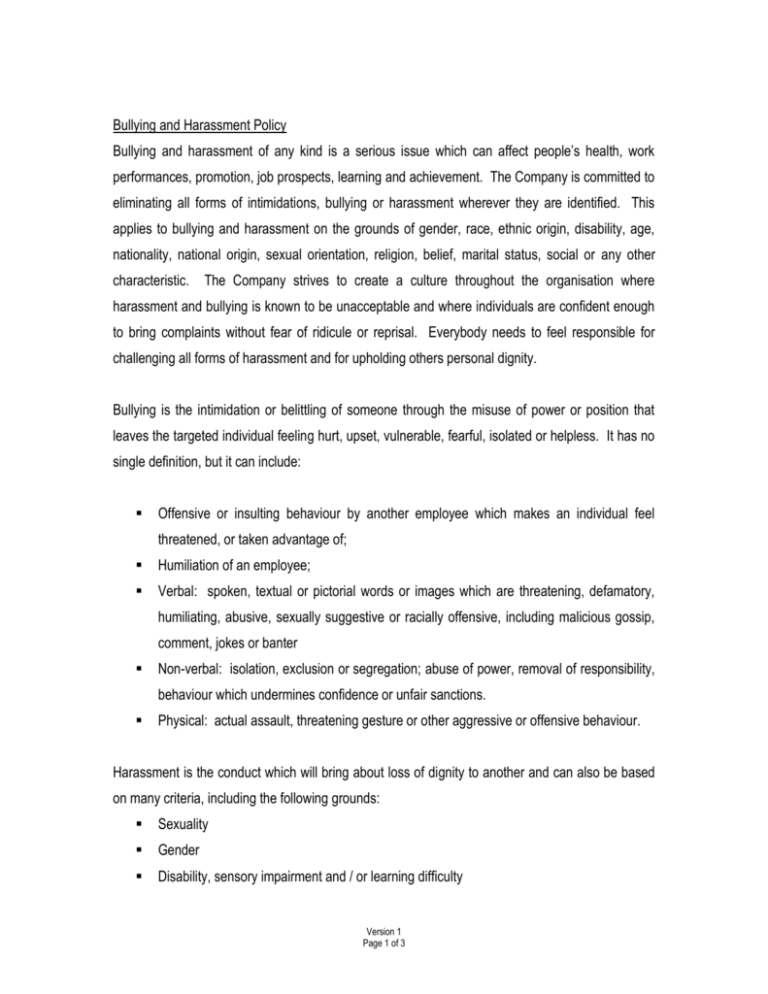Bullying and Harassment Policy
advertisement

Bullying and Harassment Policy Bullying and harassment of any kind is a serious issue which can affect people’s health, work performances, promotion, job prospects, learning and achievement. The Company is committed to eliminating all forms of intimidations, bullying or harassment wherever they are identified. This applies to bullying and harassment on the grounds of gender, race, ethnic origin, disability, age, nationality, national origin, sexual orientation, religion, belief, marital status, social or any other characteristic. The Company strives to create a culture throughout the organisation where harassment and bullying is known to be unacceptable and where individuals are confident enough to bring complaints without fear of ridicule or reprisal. Everybody needs to feel responsible for challenging all forms of harassment and for upholding others personal dignity. Bullying is the intimidation or belittling of someone through the misuse of power or position that leaves the targeted individual feeling hurt, upset, vulnerable, fearful, isolated or helpless. It has no single definition, but it can include: Offensive or insulting behaviour by another employee which makes an individual feel threatened, or taken advantage of; Humiliation of an employee; Verbal: spoken, textual or pictorial words or images which are threatening, defamatory, humiliating, abusive, sexually suggestive or racially offensive, including malicious gossip, comment, jokes or banter Non-verbal: isolation, exclusion or segregation; abuse of power, removal of responsibility, behaviour which undermines confidence or unfair sanctions. Physical: actual assault, threatening gesture or other aggressive or offensive behaviour. Harassment is the conduct which will bring about loss of dignity to another and can also be based on many criteria, including the following grounds: Sexuality Gender Disability, sensory impairment and / or learning difficulty Version 1 Page 1 of 3 Race, ethnicity, skin colour and / or nationality Culture and religion Class Political beliefs Membership or non-membership of a trade union Status as an ex-offender Age Physical height of size Facial scarring or other features This is not an exhaustive list and, if harassment takes place for different reasons, it will be the appropriate Director’s decision. Harassment may be repetitive or an isolation occurrence against one or more individuals. It may equally be part of a pre-meditated campaign of some of the behaviour described above. It is not the intention of the perpetrator of the bullying or harassment that is of primary concern; but rather the conduct itself and its impact on the recipients which constitutes. The Company is committed that all instances / allegations of bullying or harassment that are received either informally or formally, are dealt with promptly, sensitively, fairly, objectively, confidentially and seriously through the established procedure. Procedure Ideally, complaints should be dealt with internally and informally. In many cases it is sufficient for the recipient of harassment to raise the problem with the perpetrator, pointing out the unacceptable behaviour. But if an employee finds this difficult or embarrassing, this informal procedure can allow support from a colleague, an appropriate manager or a member of the Human Resources team. There will be times, however, when the informal route is not appropriate or has not previously worked. In these circumstances a more formal route must be adopted. Version 1 Page 2 of 3 Investigation: Formal allegations of harassment, bullying or any intimidating behaviour will be treated as a disciplinary offence. A detailed investigation will be undertaken, and will be: Prompt and thorough Undertaken by independent and objective individuals Representation from both parties will be involved Confidentiality will be maintained Following an investigation – should there be a case to answer – the Company Grievance and Disciplinary procedure will be followed. Should the offence be of a significantly serious nature, it may be classed as gross misconduct and lead to dismissal. Version 1 Page 3 of 3



![Bullying and Harassment Advisor role des[...]](http://s3.studylib.net/store/data/006976953_1-320eb77689e1209d082c9ec2464350ee-300x300.png)




